Black Sea Fleet during the First World War. Part of 3
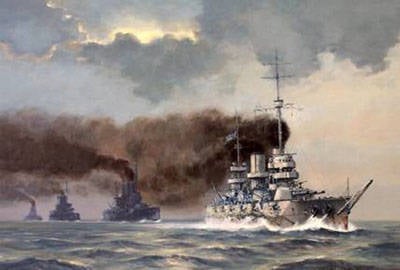 1916 year
1916 yearIn 1915, the Black Sea Fleet strengthened its superiority and almost completely controlled the sea. Three brigades of battleships were formed, destroyer forces were active, submarine forces and naval forces were increasing their combat experience aviation. Conditions were created for the Bosphorus operation.
In 1916, evil rock threw up some unpleasant "surprises": on August 14 (27), Romania entered the war on the side of the Entente, but since its armed forces were of very dubious combat effectiveness, they had to be strengthened by Russian troops, the Black Sea Fleet also helped with sides of the Balkan coast and the Danube. Underwater threat intensified the fleet, German submarine forces in the Black Sea grew to 10 submarines. The Black Sea Fleet did not have anti-submarine protection, so it had to be created at the approaches to Sevastopol.
In 1916, the fleet at one time performed several important tasks:
1) continued to block the Bosphorus Strait;
2) regularly supported the right flank of the advancing Caucasian front;
3) assisted the troops of Romania and the Russian units stationed there;
4) continued to disrupt enemy sea communications;
5) protect their bases and communications from enemy submarine forces, his cruising raids.
The main link was considered to be the blockade of the strait, which was of great military-strategic importance. Using the mine experience of the Baltic Fleet, it was decided to close the Bosphorus mine. From July 30 to August 10, a mine-fencing operation was carried out, 4 barriers were delivered, only about 900 min. Until the end of the year, more 8 installations of mines were made, with the task of strengthening the main barrier and blocking coastal waters - to interfere with small vessels and submarines. A total of 14 mine chains were delivered during the war (about 2200 mines). For the protection of minefields from minesweepers, a patrol of destroyers and submarines was established, and since the end of the summer mainly submarine forces have been on duty.
In the minefields, the enemy lost several warships, submarines, 10-ki transport steam and sailing ships. The mine blockade violated Turkish shipping, the Ottoman capital began to experience difficulties in the supply of food and fuel. But the complete blockade of the Bosphorus failed to be implemented.
The large-scale character was of assistance to the actions of the Caucasian front, it was permanent and played an important role in conducting offensive operations, for example, Trapezudskaya. The fleet supported the ground forces with artillery, landed distracting landings, sabotage detachments, covered them from a possible strike from the sea, and supplied supplies and reinforcements. Transportation of troops and supplies was carried out by a special transport flotilla (in 1916 g - 90 ships).
So at the beginning of 1916, the Batumi destroyer squadron, 2 th gunboats ((“Donets”, Kubanets)) 2 th destroyers (“Strict” and “Swift”) were reinforced. The battleship " Rostislav "and destroyers" Lieutenant Pushchin "," Alive. "
Aviation of the Black Sea Fleet
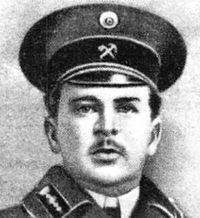 The Russian Empire was one of the world leaders in the theory of the use of aircraft at sea and the construction of seaplanes. Back in 1910, the well-known Russian test pilot LM Matsievich wrote about the importance of using airplanes in the maritime industry and the construction of seaplanes. In 1911-1912 He was supported by the inventor D. P. Grigorovich. The work on hydroaviation in Russia kept pace with other leaders in the field of aircraft manufacturing: A. Faber’s first French seaplane in 1910; American aircraft G. Curtis; and Russian “Gakkel-V” in 1911 year.
The Russian Empire was one of the world leaders in the theory of the use of aircraft at sea and the construction of seaplanes. Back in 1910, the well-known Russian test pilot LM Matsievich wrote about the importance of using airplanes in the maritime industry and the construction of seaplanes. In 1911-1912 He was supported by the inventor D. P. Grigorovich. The work on hydroaviation in Russia kept pace with other leaders in the field of aircraft manufacturing: A. Faber’s first French seaplane in 1910; American aircraft G. Curtis; and Russian “Gakkel-V” in 1911 year.After the plane of Ya. M. Gakkel, the planes of I. I. Sikorsky were created in 1912. However, the navy ministry did not support the good beginnings of Russian inventors in 1911 — 1913. were purchased seaplanes of American and French brands.
Since 1913, it has been developed into a wider construction of domestic seaplanes. The main role in this business belonged to Russian designers, and not to the state. They were able to quickly create projects of naval aircraft that surpassed foreign ones and soon drove them out of Russian naval aviation. These devotees are Grigorovich, Villish, Engels, Sedelnikov, Frida, Shishmarev, as well as the design office of the Russian-Baltic Carriage Plant and the Aviation Testing Station. Prior to 15, the aircraft released in Russia was of water designation, this was not the case anywhere in the world.
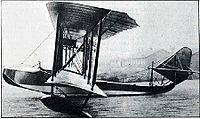 At the beginning of the war on the Black Sea there were 8 seaplanes, based on the Curtis type. The head of the Navy Communication Service was Senior Lieutenant Stakhovsky. The planes were based at the station of the 1 discharge in Sevastopol (Killen Bay), the stations of the 1 discharge were built in Ovidiopol, Ak-mosque; station 2-th category - Zolokharah and Klerovke. Before the war, 3 were created, and then 24 observation posts, from the Danube to Batum. This made it possible to quickly transfer aircraft along the entire Russian coast of the Black Sea. At the end of 1914, the hangars from Ovidiopol and Ak-mosques began to be transferred to the Round Bay in Sevastopol and in May 1915 opened the air station.
At the beginning of the war on the Black Sea there were 8 seaplanes, based on the Curtis type. The head of the Navy Communication Service was Senior Lieutenant Stakhovsky. The planes were based at the station of the 1 discharge in Sevastopol (Killen Bay), the stations of the 1 discharge were built in Ovidiopol, Ak-mosque; station 2-th category - Zolokharah and Klerovke. Before the war, 3 were created, and then 24 observation posts, from the Danube to Batum. This made it possible to quickly transfer aircraft along the entire Russian coast of the Black Sea. At the end of 1914, the hangars from Ovidiopol and Ak-mosques began to be transferred to the Round Bay in Sevastopol and in May 1915 opened the air station.From August to the end of October, 1914 (before the outbreak of war with the Ottoman Empire), managed to complete the deployment of air units, train personnel, develop some tactical techniques. It became clear that the aircraft can be used to detect sea mines and enemy submarines.
Since the beginning of the war on the Black Sea Fleet, two steamboats were rebuilt into aircraft "womb": "Emperor Nicholas I" and "Alexander I"; then they were joined by the hydrotreumer "Romania". They could carry 6-8 aircraft. In addition, the 1-n hydroplane was stationed on the Almaz cruiser.
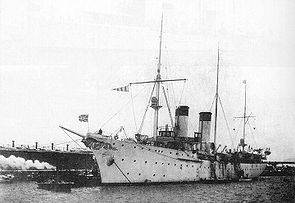 The first experience of using naval aviation was 24 March 1915 of the year: the Russian squadron made a trip to Rumelia (r. Turkey in Europe), the squadron was "Nikolai I" with 4 aircraft. They planned to use them for aerial reconnaissance, but then they were used for bombing of coastal targets. This was the first experience of the Russian naval aviation off enemy coasts. March 27 1915 squadron with the participation of 2-x air transport (the cruiser "Almaz", "Nikolai"), the aircraft conducted reconnaissance of the strait and found that there were no large ships, dropped 3 bombs on the coastal fortifications and destroyer.
The first experience of using naval aviation was 24 March 1915 of the year: the Russian squadron made a trip to Rumelia (r. Turkey in Europe), the squadron was "Nikolai I" with 4 aircraft. They planned to use them for aerial reconnaissance, but then they were used for bombing of coastal targets. This was the first experience of the Russian naval aviation off enemy coasts. March 27 1915 squadron with the participation of 2-x air transport (the cruiser "Almaz", "Nikolai"), the aircraft conducted reconnaissance of the strait and found that there were no large ships, dropped 3 bombs on the coastal fortifications and destroyer.By April, the 1915 fleet had grown to 18 aircraft, in April, the 5 fleet of the FBA arrived, in May, the old Curtis aircraft began to replace the M-5 hydroplanes by designer D. P. Grigorovich.
3 May Russian seaplanes made 1-th raid on the Ottoman capital - Istanbul. These actions showed that aviation is beginning to play a large role not only for reconnaissance, but also for attacking actions. By the end of the year, combat training was improved, the interaction of the crews of airplanes and ships. In October 1915, the Russian squadron made a march to the shores of Bulgaria, Varna and Euxinograd were fired, and an air raid was made on 25.
On 1 in January, the 1916 in the Black Sea squadron was: 30 officers, 371 other personnel, 30 aircraft, 2 air transport and the cruiser “Almaz”. At the end of the year, another air transport “Romania. The Black Sea detachment consisted of 1 and 2 th ship detachments (on the “Nikolay” and “Alexander” - 13 pilots), the hydro-aviation detachment of the Caucasian Front (8 pilots), the combat training unit in the Round Bay (5 pilots), the formation of the detachment of the conductor began. .
8-15 January, exercises were held, practiced techniques of aerial photography, reconnaissance, bombing. On January 24, the Russian squadron approached Zunguldak. Zunguldaksky coal district was the second most important area of influence of the Russian fleet (after the Bosphorus). Due to the underdevelopment of the railway network, coal was transported mainly by sea. Usually, only ships delivered a strike on it, the pilots were ordered to bomb the steamer, the secondary objectives were a port, a power station, a railway. Although the pilots were hampered by heavy clouds and anti-aircraft fire, they were able to dump 18 large and 20 small bombs, set fire to and sank the 7000-ton steamer and several ships, destroyed the railway junction building, set fire to several mines.
A similar operation was carried out on 25 in August against the Austro-German forces in Varna, but this time the enemy put up strong resistance, when the squadron left it was attacked by enemy aircraft that dropped several dozen bombs.
Another task for the hydroaviation was to assist in conducting large landing operations. In April, 1916, both air transport are accompanied by a transport fleet of 27 ships from Novorossiysk and Mariupol in the district of Rize. The aircraft covered the landing forces from the air and carried out anti-submarine defense. A month later, "Alexander" participated in the landing of troops at Trebizond.
At the beginning of December 1916, the squadron included X-NUMX M-45 seaplanes (reconnaissance, artillery spotter), 5-M-45 (heavy seaplane for bombing land objects and ships), 9-M-10 (first in the world (!) seaplane-fighter) all Russian production, designer D. P. Grigorovich.
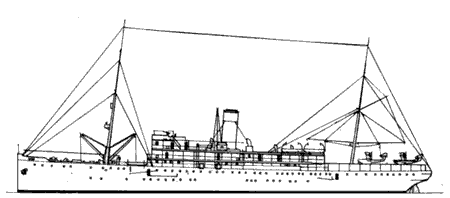
The order for the fleet identified the tasks of naval aviation:
1) attack of enemy ships, its bases and coastal fortifications;
2) fighting with the enemy air forces;
3) anti-submarine warfare;
4) surveillance and aerial reconnaissance;
5) the protection of the fleet at sea from enemy aircraft and its submarines;
6) adjustment of ships artillery fire.
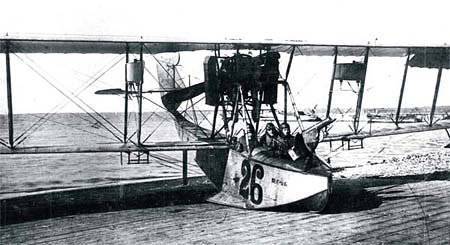
By the beginning of 1917, naval aviation forces had grown to 110 aircraft, in the summer 8 ground fighters (Newpor) arrived. An air division of the Black Sea was formed - the 1 brigade consisted of 4 ship detachments (then 6), the 2 brigade 13 land-based brigades. In March, the 1917 of the year was to begin a grandiose operation to capture the Bosphorus, it was supposed to be supported by more than 150 seaplanes from the air, but the death of the empire destroyed the plans of this operation. After the February Revolution, "Alexander" was renamed "Republican", and "Nikolai" in "Aviator". May 24-27 The Aviator made its last trip to aerial photography and the bombing of Sinop. The further activities of the Black Sea Fleet naval aviation ended in connection with the outbreak of the Civil War, the pilots were scattered about different sides of the front.
The mystery of the death of the battleship "Empress Maria"
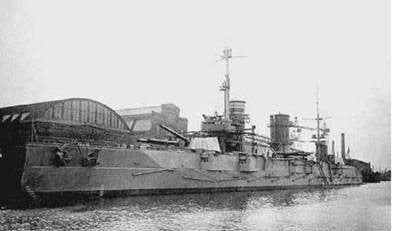
The Russian-Japanese war revealed a number of significant shortcomings of the Russian fleet, the battleships are outdated. England is building a new battleship "Dreadnought", but Russian inventors are not inferior to world advanced developments. Russian shipbuilders built battleships ("dreadnoughts") according to the idea of I.G. Bubnova and A.N. Krylov, which in many respects surpassed the English prototype. In 1909, the ships “Sevastopol”, “Gangut”, “Poltava” and “Petropavlovsk” were laid in the Baltic shipyards.
Linear placement of 12-305-mm guns, in three-gun turrets, made it possible to shoot from both sides at the same time with all guns. The weight of the volley of one of the first English battleships of the new type of “Vengard” was 3003 kg, on the “Sevastopol” it reached 5650 kg. In one minute, the Russian battleship shot down tons of metal and explosives to 11,5. The main armor belt was 225 mm thick. For the Black Sea Fleet in the Nikolaev shipyard in 1915-1917, the battleships “Empress Maria”, “Emperor Alexander III” and “Catherine II” were built according to the “Imperator” project. 4 dreadnought “Emperor Nicholas I” was laid in 1915, but was not completed due to the revolutionary events.
25 June 1915, the battleship Empress Maria left the port of Nicholas and, guarded by a squadron, headed for Sevastopol. This day became a holiday for shipbuilders and for the entire Black Sea Fleet. 13-15 October 1915, the battleship covered the actions of the 2-th brigade of battleships in the district of Zunguldak. 2-4, 6-8 in November 1915 covered the 2 brigade from the sea during the shelling of Varna and Evksinograd from the sea. From February 5 to April 18 assisted the Trabzon operation. During the hostilities, it became clear that the battleships of the "Empress Maria" type justified the hopes placed on them. During the first year of service, the ship made 24 combat trips, sank quite a few Turkish ships.
In the summer of 1916, by decision of the Supreme Commander (Emperor Nicholas) of the Russian Army, the Black Sea Fleet was headed by Vice Admiral Alexander Kolchak. The admiral made the "Empress Maria" the flagship of the fleet and systematically went on it at sea. Having laid a glorious initiative, in the fall of 1916, the battleship was installed in the Sevastopol preventive maintenance raid. And this autumn has become fatal for "Empress Maria".
The morning of October 7 (20). 1916 of the year did not bode ill, it began an ordinary day. Above the North Bay every day was a wake to the crews of ships. On the battleship, everything went according to a certain usual routine. Suddenly, in a 6.20 neighborhood, a powerful explosion shook, then lasting about another hour, 15 explosions. The frightened Sevastopol ran to the embankment and witnessed a terrible picture. Standing in the raid in his native bay, the battleship "Empress Maria" was dying. The ship lurched on the starboard side, rolled over and sank. The wounded were located right on the beach and were given first aid there. There was black smoke above the city. By the evening, the size of the disaster became known: the 225 sailors died, 85 was seriously injured, the most powerful ship of the Black Sea Fleet was killed.
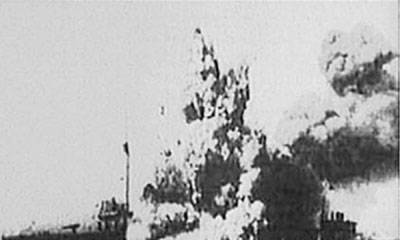
Tragedy shook the entire Russian Empire. Determining the causes of the ship’s death was taken up by a commission of the Marine Ministry, headed by a military officer (adhering to Port Arthur), a member of the Admiralty Council, Admiral N. M. Yakovlev. A well-known shipbuilder, one of the authors of the project of the Black Sea battleships, an associate of Admiral S. O. Makarov, academician A. N. Krylov, who made a conclusion, which was approved by all members of the commission, became a member of the commission.
Three major versions of the death of the battleship were put forward:
1. spontaneous combustion of gunpowder;
2. careless handling of fire or gunpowder;
3. evil intent.
The commission was inclined to the second version (negligence), since the gunpowder was, in the opinion of all the battleship gunners, high-quality. As for malicious intent, even finding violations in the rules for access to artillery cellars and lack of control over the workers on the ship. For example: Prince Russov, the head of the ship’s armament, pointed out that the hatch in the powder magazine was not locked or protected at all. The commission found this version unlikely. As a result, none of the hypotheses put forward by the commission found sufficient facts to confirm.
Also, the Sevastopol gendarme department and counterintelligence created by the sailors at the end of 1915 were engaged in investigating the causes of the explosions. But they could not reach the true cause of the death of the flagship. The revolutionary events finally stopped the investigation.
German trace: already in the Soviet period, it became clear that Germany was closely watching all changes in the Russian fleet, including new dreadnoughts. And in Germany, they understood how dangerous Operation Tsargrad (Bosphorus operation) was, where the battleships had to play a very important role. In the 1933 year, during an investigation into sabotage at the Nikolaev shipyard, the Stalinist Chekists exposed the German intelligence network led by V.E. Verman. The purpose of the organization was the disruption of the shipbuilding program of the USSR military and merchant fleet. In the course of the investigation, many interesting facts came to light, dating back to the pre-revolutionary period. Verman himself was a scout with experience (he was a senior electrical engineer), he began his work as early as 1908, when a large-scale Russian fleet restoration program began. The network covered all major cities of the Black Sea region, special attention was paid to Odessa, Nikolaev, Sevastopol, Novorossiysk.
During the interrogation, Werman reported that German intelligence was planning a sabotage on the battleship, and led a group of saboteur Helmut von Stitgoff. He was considered the best specialist in the field of mining and undermining ships. In the summer of 1916, Helmut Von Stitgoff began working at the Nikolaev shipyard as an electrician. It was planned to blow up the battleship right in the shipyard. However, something broke, Stitgoff immediately turned the operation and left for Germany. But Verman's group continued to work independently and did not curtail its activities, it had the opportunity to access the battleship. After an unsuccessful attempt to undermine the warship "Empress Maria" Helmut von Stitgoff, the command was transferred to the next mission. During this period, he tried to recruit British intelligence (someone Haviland).
In 1942, the honored saboteur of Germany Helmut von Stitgoff was shot by the secret police (Gestapo). The trail leading to the death of the battleship "Empress Maria" was erased.
1945 year - Koenigsberg, a German archive was found in a destroyed house by Soviet soldiers. They found an album in which there was a whole series of shots of the battleship "Empress Maria", one of the pictures shows the moment of the explosion. It seems as if someone knew in advance the time and place of the diversion and carefully took everything off.
English trace: the night before the death of the giant, Voronov, the commander, was on duty at the main tower. His duties were: inspection and measurement of the temperature of the artillery cellar. This morning, the captain of the 2 rank, Gorodyskiy, was also on combat duty on the ship. At dawn, Gorodissky ordered his Voronov to measure the temperature in the cellar of the main tower. Voronov went down to the cellar and nobody saw him again. And after a while the first explosion thundered. The body of Voronov was never found among the bodies of the dead. The commission had suspicions about him, but there was no evidence and he was recorded as missing.
But recently there was new information: the English writer Robert Merid, who had long been engaged in the mysterious death of the battleship, undertook his own investigation. And from it we learn very interesting (and shameful for the "ally" of the Russian Empire) information. After the war ended, Lieutenant Maritime British Intelligence retired served in Russia from 1914 to 1916 years, a week after the explosion, he left Russia and arrived in England as a lieutenant colonel. After the end of the war he retired and left the country. After some time, he appeared in Canada, bought an estate, began to equip it, lived the ordinary life of a rich gentleman. And in 1929, he died under strange circumstances: in a hotel where he spent the night there was a fire, everyone was saved (including a woman with a small child and a paralyzed old man in a wheelchair), and the combat officer could not escape from the 2 floor.
This begs the question - whom did the colonel in the deep periphery of the world processes prevent him from, being in retirement. Photo archives research has led to unexpected results - the lieutenant colonel of English intelligence, John Haviland and the battleship of the “Empress Maria” battleship Voronov is one and the same person. The same Ravens, disappeared 7 October 1916, at the time of the explosion of the battleship "Empress Maria".
It is also interesting that some Russian immigrants, including the former electrician of the “Empress Maria” battleship Ivan Nazarin, attempted upon him shortly before his death. Maybe they also went on the trail and tried at least somehow to avenge their ship !?
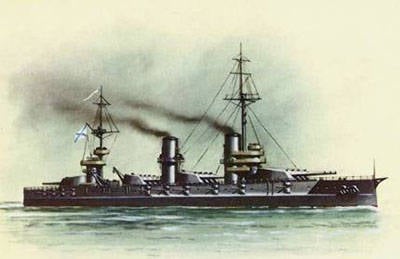
Conclusion, in any crime are important motive and opportunity. German intelligence had both motive and opportunity. Destroying the battleship, they helped their ally (the Ottoman Empire), disrupted the terms of the Bosporus operation, inflicted a heavy psychological blow on their main opponent. And the opportunity was: to the great regret, the Security Service was not developed in the Russian Empire, any agent of the German intelligence network could penetrate the battleship under construction (and not just one), and since it could work there, it could carry the “hellish machine”. Anyone familiar with the realities of Soviet-Russian factories will confirm this: you can take out something, or bring it in.
The British Empire was an ally of Russia in that war, but of course stories it is known that a powerful reconnaissance and sabotage service appeared in it in one of the first, and even Britain was an old enemy of the Russian Empire. The motive for the destruction of the battleship? The horror of the English elite was thinking about the day when the “shield of Oleg” would be nailed to the gates of Constantinople again. It would be the day of the collapse of the age-old machinations and intrigues of England against Russia. The straits were not supposed to go Russian at any cost. The possibilities of English intelligence in Russia were no worse than the German ones; moreover, England often did her business by someone else’s hands. Perhaps the battleship was destroyed by the forces of the German intelligence network, but under the leadership of the British. And the cover is good, who is to blame (?) - the Germans!
On the resignation of Admiral A. A. Eberhard (July 1916)
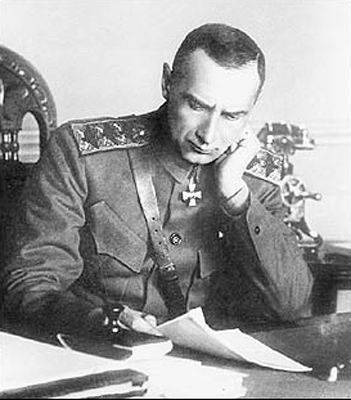
In the summer of 1916, Admiral A. A. Ebergard was replaced by Admiral A. Kolchak. The reasons for this event are not the failures and mistakes of Aberhard, but rather a tribute to court circles and public opinion.
A.A. Eberhard did not listen to the opinions of the greats of the world, acting on the basis of the interests of the Black Sea Fleet, angered them and Emperor Nicholas decided to compromise. Ebergard went to the honorary exile to the State Council, and was replaced by a young admiral, who continued to do the same that the fleet did before him.
This story began from the very beginning of the war, when the German cruisers entered the straits (10 in August 1914), the Ottoman Empire was then a neutral country and had no right to let warships pass through the straits. A.A. Eberhard made a decision to go the whole fleet to Istanbul and demand their access to the Mediterranean Sea, where the English squadron was waiting for them. In case of refusal, he wanted to attack them right on the raid, where their speed advantage disappeared. This plan was Russian in spirit, in the best traditions of F. F. Ushakov and P. S. Nakhimov. But the government categorically forbade it to do, they still hoped that Turkey would not enter the war.
Even when the German-Turkish fleet went to sea, obviously not for a walk, Aberhard was restrained with orders not to “provoke” the enemy. As a result, received a "Sevastopol wake-up." But here, too, the admiral did not fulfill the directive of the Supreme Commander (Grand Duke Nikolai Nikolayevich), about the main task - “defense of his shores” and immediately responded by marching to the shores of the enemy. The admiral understood that he could only defend his shores by eliminating the enemy’s ships from the Black Sea. The best defense is attack. In the Stavka, not everyone understood this and it came even to the direct insults of the "great" prince admiral. But the admiral apparently understood that the Motherland is one, and there are many fools and continued to do their work.
18 November 1914 German admiral Souchon attempted to intercept Aberhard, who was returning after the shelling of Trebizond. "Intercepted", but received "on the nose." Since then, Souchon no longer sought a battle with the entire Russian squadron, but confined himself to tactics on the pirate principle - “Hit and leave.” Soon, “Goeben” hit a Russian mine near the Bosphorus and went out of service for several months.
At the beginning of 1915, new high-speed destroyers of the Novik type began to arrive in the fleet. This made it possible to proceed to constant strikes on the coast of Turkey, destroying enemy transports, destroying its navigation.
After the repair, “Goeben” resumed raids on the Russian coast. These attacks brought minimal damage, but the Petersburg light was very annoying. In addition, 1915 was a very difficult year for Russia, the initial patriotic frenzy came down, difficulties came over. Creeping talk of the “treason of the German admiral” began, although his family was of Swedish descent. The command demanded to protect their shores, while Ebergard continued to destroy the enemy’s naval forces.
The second battle of the Russian battleships with “Goeben” near the Bosporus (May 1915) was also in favor of A. A. Aberhard. German-Turkish fleet could not prevent in the year 1916 several landings of troops. The Black Sea Fleet confidently controlled the sea, which, like the old (with the first Rurikovich), was once again becoming Russian. But Petrograd did not know much about the small victories of the Black Sea Fleet, which were preparing the common Victory with small bricks. Dirty talk of the admiral’s passivity and lack of talent continued; that the Germans rule over the sea, apparently some forces sponsored a part of the newspapers.
At the end of May 1916, the Russian battleships bombard Varna, from the sea they are covered by the "Empress Maria". The English admiral Phillimore, who was present at the Panteleimon, called, after this campaign, the Russian linear fleet: "The best military unit in the world." This campaign coincided with the intensification of the activities of the German submarine forces, and on July 4 1916 “Geben” fired at Tuapse.
This was the last straw, A. A. Eberhard was replaced by A. Kolchak. But, interestingly, he did the same as A. A. Ebergard: he continued mining the exit from the Bosporus (the Geben, 6 of German submarines was blown up again) to block the Turkish forces; Russian destroyers and submarines tormented the Turkish coast with their cruising operations. One of the reasons for the appointment of Kolchak was that he was believed to be an expert in amphibious operations and a mine case.
And since the end of 1916, a systematic preparation for “Operation Constantinople” was going on: trainings for landing and landing troops were under way, constant reconnaissance exits to the Bosphorus were under way, the coast was carefully studied, and aerial photography was under way. Kolchak had every chance to enter the history of the empire as a hero who hoisted the Russian flag over the ancient capital of the Christian world.
Information